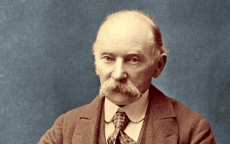
Thomas Hardy is known the world over for his dramatic stories about Wessex. He’s the most famous person to ever come out of Dorset, my beloved home county. His most famous work is Tess of the D’Urbervilles, a tale about a woman who is betrayed by men and meets a tragic end, after a hard life. It sounds depressing, but that’s because the life of a rural peasant wasn’t easy in Victorian times. Paintings and novels often romanticised the lives of poor, country folk, and Thomas Hardy set about rectifying that issue.
Hardy was born to an upper working class family near Dorchester, the county town of Dorset. His family couldn’t afford to send him to university, so he left school at 16. He eventually saved up the money himself to go to King’s College, now part of the University of London. But he returned to Dorset soon afterwards, and decided to dedicate his life to writing about the county he loved. His writing was recognised by many at the time as being of a very high standard, and was nominated for the Nobel Prize in literature twice. He died in Dorset, but has been buried in Westminster Abbey’s “Poet’s Corner”, alongside writers such as Chaucer and Dickens.
As well as many books, Hardy also wrote lots of poems. Poems like “The Blinded Bird” and “The Man He Killed” reflect his opinions on political issues, like animal cruelty and war, respectively. His poems weren’t as popular as his novels, though. As well as Tess of the D’Urbervilles, Hardy wrote Far From the Madding Crowd, The Mayor of Casterbridge, and Jude the Obscure. Themes in his work often cover class divisions, relationships between men and women, and the role of chance in the lives of ordinary people.
Thomas Hardy’s work is mostly set in Wessex, which roughly corresponds to the old Anglo-Saxon Kingdom. Major towns included Casterbridge (Dorchester) and Christminster (Oxford). The region was very large, and included Cornwall, Devon, Dorset, Somerset, Hampshire, even as far east as Windsor. If you go to Dorset, you’ll find the National Trust owns both Hardy’s birthplace, and Max Gate, a house he designed for himself. So you can go round and have a look! Maybe you’d like to take a tour of the county based on the places in his works, you’ll really feel like his work is coming to life.
Thomas Hardy is still relevant to many of us, not least because we study him at A-Level. Some of the themes he covered in his work truly challenged the strict Victorian conventions of the day – he wrote complicated female characters, he showed how marriage and sexual conventions could be repressive, and even his views on religion were ambiguous. Lots of students complain and says he spends far too long talking about the Dorset countryside, but the Dorset countryside is a very interesting and beautiful place, so there’s a lot to say! So if you ever have to study him at school, keep an open mind. He’s very different to lots of the other authors at the time, and who knows? Maybe all that talk of fresh air and the countryside will rub off a little on you. Perhaps you’ll find him as refreshing as the Dorset air itself.
Image from: http://www.telegraph.co.uk/culture/books/10563431/Top-15-most-depressing-books.html

0 Comment:
Be the first one to comment on this article.